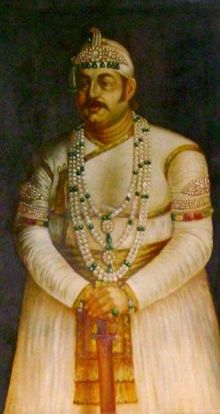Afzal-ud-Daulah
 From Wikipedia the free encyclopedia
From Wikipedia the free encyclopedia
This article needs additional citations for verification. (August 2020) |
| Afzal ad-Dawlah GCSI | |||||
|---|---|---|---|---|---|
| Āṣaf Jāh V Niẓāmu ʾl Mulk Afḍalu ʾl Daūlah | |||||
 | |||||
| 8th Nizam of Hyderabad State | |||||
| Reign | 16 May 1857 – 26 February 1869 | ||||
| Predecessor | Nasir-ud-dawlah, Asaf Jah IV | ||||
| Successor | Mir Mahboob Ali Khan, Asaf Jah VI | ||||
| Born | 11 October 1827 Gufran Manzil, Hyderabad State, British India | ||||
| Died | 26 February 1869 (aged 41) Hyderabad, Hyderabad State, British India | ||||
| Burial | |||||
| Spouse |
| ||||
| Issue | Mir Mahboob Ali Khan Siddiqi, Asaf Jah VI Hussain-un-Nisa Begum Jahandar-un-Nisa Begum Parvarish-un-Nisa Begum Siraj-un-Nisa Begum | ||||
| |||||
| House | Asaf Jahi | ||||
| Father | Nasir-ud-dawlah, Asaf Jah IV | ||||
| Mother | Dilawar-un-Nisa Begum | ||||
| Religion | Sunni Islam | ||||
Afzal ad-Dawlah, Asaf Jah V Mir Tahniyat Ali Khan Siddiqi (11 October 1827 – 26 February 1869) was the eighth Nizam of Hyderabad, India, from 1857 to 1869.[1]
Realm[edit]
Asaf Jah V's realm was divided into five subahs and sixteen districts; each subah was headed by a Subedar and each district by a Taluqdar.[citation needed]
Developmental reforms[edit]
Hyderabad Medical School[edit]
He set up the Hyderabad Medical School (HMS) in 1846 which later came to be known as Osmania Medical College.[2]
Rubath for pilgrims of Hyderabad State[edit]
The Nizam's Rubath is an accommodation building purchased by the 5th Nizam for the people of Hyderabad State travelling for their Holy pilgrimage (Hajj) to city of Mecca.[3][4] It initially consisted of 42 buildings, but with the expansion of the Grand Mosque, only three buildings remain.[citation needed]
Other reforms[edit]
Other reforms during his reign, by his Prime Minister Salar Jung, included the establishment of a governmental central treasury in 1855.[citation needed]
Asaf Jah V reformed the Hyderabad revenue and judicial systems, instituted a postal service and constructed the first rail and telegraph networks. In 1861 he was awarded the Star of India.[5]
During the regime of the Nizam V- Mir Tahniyath Ali Khan Siddiqi (Afzal-ud-Dawlah), Dar-ul-Uloom, the first regular educational institution of Hyderabad, was set up in 1854.[6]
Personal life[edit]
Asaf Jah V was the eldest son of Nasir-ud-dawlah, Asaf Jah IV (Mir Farqunda Ali Khan) and his wife Dilawar-un-Nisa Begum (buried in Makkah Masjid, Hyderabad).[7]
- Consorts
He was married three times, firstly to Mahbub Begum,[8] secondly to Hussaini Begum,[9] and thirdly to Allah Rakhi Begum.[10]
- Sons
- A son (7 June 1858 – 23 September 1858) – with Mahbub Begum;[8]
- Hifazat Ali Khan (2 May 1860 – 8 September 1861, buried near the tomb of Barhana Shah) – with Hussaini Begum;[9]
- Mahboob Ali Khan (17 August 1866 – 29 August 1911) – with Allah Rakhi Begum;[10]
- Daughters
- Hussain-un-Nisa Begum, married on 29 May 1859 to Khurshid Jah Muhammad Muhi-ud-Din Khan Bahadur Tegh Jang;[11][12]
- Parvarish-un-Nnisa Begum, married on 28 November 1869 to Nawab Bashir ud-Daulah Asman Jah Bahadur, son of Sultan-ud-Din Khan;[13][14]
- Siraj-un-Nisa Begum, betrothed on 15 November 1877 and married on 19 January 1879 to Vazier Ali Pasha;[15]
- Jahandar-un-Nisa Begum, married to Iqbal-ud-Daulah Viqar-ul-Umara;[14]
Death[edit]
He died in Hyderabad on 26 February 1869, after a reign of just 12 years and was buried at the Mecca Masjid mosque.[citation needed]
Style and titles[edit]
His Highness Sir Nizam-ul-Mulk, Afzal ad-Dawlah, Nawab Farooqi Mir Tahniat Ali Khan Bahadur, Asaf Jah V, GCSI, Nizam of Hyderabad.[16]
See also[edit]
References[edit]
- ^ Law, John. Modern Hyderabad (Deccan). pp. 25–27.
- ^ Shahzore, Dr Mohammed Najeeb (5 July 2020). "Chloroform & how modern medicine came to Hyderabad". The Asian Age.
- ^ "Hajj 2018: Draw for free accommodation at Nizam Rubath today in Hyderabad, Telangana". ummid. 10 April 2018.
- ^ Aug 2, Syed Akbar. "Nizam: Nizam descendants demand new properties be acquired for Rubat | Hyderabad News - Times of India". The Times of India. TNN.
{{cite news}}: CS1 maint: numeric names: authors list (link) - ^ Law, John. Modern Hyderabad (Deccan). pp. 34–37.
- ^ "Osmania University first to teach in blend of Urdu and English".
- ^ Bilgrami, S.A.A. (1992). Landmarks of the Deccan: A Comprehensive Guide to the Archaeological Remains of the City and Suburbs of Hyderabad. Asian Educational Services. p. 36. ISBN 978-81-206-0543-5.
- ^ a b Rao 1954, p. 286.
- ^ a b Rao 1954, pp. 289, 292–293.
- ^ a b Mukhopādhyāẏa, A. (1996). Women in Indian Life and Society. Punthi Pustak and Institute of Historical Studies. p. 166. ISBN 978-81-85094-97-7.
- ^ Rao 1954, p. 288.
- ^ Qadri, S.A.U. (1939). Memoirs of Chand Bibi: The Princess of Ahmadnagar. Nawab Lutf un-Dawlah Memorial Series. Tarikh Office. p. 4.
- ^ Rao 1954, p. 307.
- ^ a b Naqvī, Ṣ.; Rao, V.K.; Satyanarayana, A. (2005). A Thousand Laurels--Dr. Sadiq Naqvi: Studies on Medieval India with Special Reference to Deccan. A Thousand Laurels--Dr. Sadiq Naqvi: Studies on Medieval India with Special Reference to Deccan. Felicitation Committee, Department of History & Department of Ancient Indian History, Culture & Archaeology, Osmania University. pp. 827, 831.
- ^ Rao 1954, pp. 38, 317–318.
- ^ "Asaf Jahis (1724-1948)". Retrieved 21 September 2019.
Bibliography[edit]
- Rao, Ekbote Gopal (1954). The Chronology of Modern Hyderabad, 1720-1890. Central Records Office Hyderabad Government.